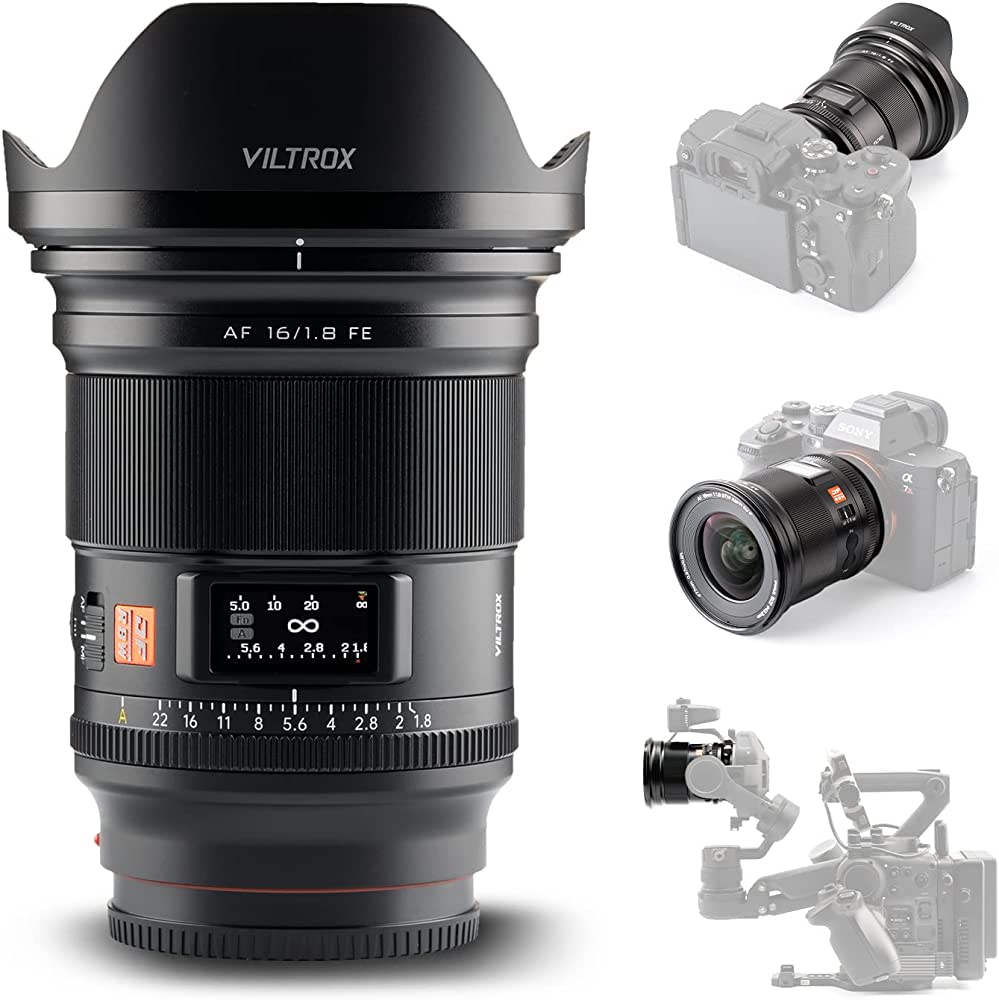Viltrox’s AF 16mm f/1.8 FE full-frame prime lens offers an intriguing combination of a wide aperture, a quick focal length, and a low $550 pricing. Can it really be that good?
I’ll be honest, I hadn’t given Viltrox much thought before. I would notice the brand name in online store catalogs, but in my mind, the business has always been grouped in with the other cheap lens brands that sell for $500 and under and rarely provide anything novel. But the 16mm f/1.8 FE lens instantly caught my attention since, while there are other full-frame 16mm f/1.8 lenses available, this one doesn’t appear to be compromising on physical design in any way. Even yet, the price is still within reach. Intriguing.
Build Quality and Design
The Viltrox 16mm f/1.8 lens has a diameter of 3.4 inches (85.2 millimeters), a length of 4.1 inches (103 millimeters), and a weight of 1 pound 3.5 ounces (552.8 grams). Although I wouldn’t describe it as compact, it is a standard-size lens that is smaller than I had anticipated a 16mm f/1.8 full-frame lens to be. The over one pound weight is largely due to the complete metal body, but it feels pleasant and sturdy in the palm.
It’s always fantastic to see physical controls on lenses like this one. Aside from the Fn1 and Fn2 buttons, there is an AF/MF toggle switch, an aperture ring with a de-click switch for smooth transitions, and an aperture ring.
However, the 160 by 80 pixel RGB IPS LCD is the item that stands out the most on the lens. This little information panel shows the aperture, Fn indicators, depth of field measurements in real time, focus distance, focus mode, and focus. Although I appreciate the effort put into making the display function within the price range of this lens, I don’t find it to be as useful as the top screens on Canon and Nikon cameras. It would make up for Sony’s faults with their cameras and be far more useful to me if there were a method to display camera parameters like shutter speed and ISO in addition to the aperture that it can already do.
I do need to take a step back and briefly expand on the Fn buttons. Fn1 is essentially the “focus hold” button in the camera that can be customized to perform anything. A little bit more unique is Fn2. When the camera is in manual focus mode, this button enables two A and B focus distances to be saved and retrieved. This was helpful to me for many focus stack exposures throughout the day, and I can see how having the stars set to B and the foreground element set to A would be really helpful for astrophotographers.
An aperture lock is something I’m lacking. During testing, it happened frequently that the aperture ring would be pushed just enough away from the “A” setting such that it switched to manual mode instead of camera controlled. This problem might have been avoided if the aperture ring could have been locked.
Positively capping off this part, the front of the camera has 77mm threads for attaching neutral density or polarizing filters. Despite being a wide lens, the front element is thankfully not too oversized to cause problems. With the Maven magnetic filter system, I can stack two filters onto the adapter ring before the effects of a third filter begin to appear in the frame’s outermost corners.


Image Quality
Three aspherical elements and four extra-low dispersion elements are among the 15 elements used internally by the Viltrox 16mm. These elements are organized in 12 groups. Additionally, a “HD Nano” coating is used, which is designed to reduce ghosting and flare while boosting contrast.
Testing sharpness in the corners, I saw between f/5.6 and f/7.1 looked best and holds pretty well until f/18, where sharpness takes a dive due to diffraction.
Vignetting with the Viltrox 16mm is something that never goes away on its own. It’s strong wide open, but by f/4 is when it reaches the best it’s going to. What remains, and there is some, will need post-processing to be removed.

All things considered, this lens offers excellent image quality for photographers who frequently use apertures between f/1.8 and f/8.
With a 105.6-degree angle of view and relatively minimal distortion, the Viltrox 16mm is hardly worth mentioning. Vertical lines towards the edge appear to be just a tiny bit pincushioned, and horizontal lines at the extreme edge appear to have a hint of mustache distortion.

Although 0.88 feet (0.27 meters) might seem close, at 16mm, flowers and other small things are still little in the frame. Only 0.1x of magnification is possible.
Although this is a wide-angle prime, at closer ranges, the f/1.8 maximum aperture can provide some respectable subject isolation. Even if its out-of-focus zones are active and aren’t really dissipating, I’m nevertheless impressed by any depth-of-field impression with such a broad angle. Bokeh balls have some rough edges and a soapy appearance, but some people like that aesthetic, so I can’t say it’s faulty.

Even while this lens may use autofocus, it’s not its strongest point, at least when used with the Sony Alpha 7R III. The STM motor rattles the camera slightly and sweeps the focus range somewhat slowly. It also emits a gentle grinding sound. Counting out “one-thousand-one,” it takes roughly “one-thousand” for it to focus from infinity to close proximity.

Viltrox, You Have My Attention
The low-cost lens manufacturers I am familiar with don’t care about making wide-open apertures appear sharp, don’t have many physical adjustments, or don’t include the Fn2 button. Viltrox has worked hard to create this lens while keeping the cost at a reasonable $550. Before, I didn’t give the company much thought, but now I do.
Alternatives?
The Viltrox 16mm f/1.8 seems to be the first full-frame prime lens 15mm to 18mm with autofocus and a sub-f/2.8 aperture. Thus, the Viltrox is not only selling for a fair price but also finding a sweet place among a sea of lens possibilities.
The Sony FE 14mm f/1.8 GM, Sony FE 20mm f/1.8 G, Sigma 20mm f/2 DG DN Contemporary, and Tokina FiRIN 20mm f/2 FE AF are two more popular prime focal lengths that open up alternatives that maintain a fast aperture, but I wouldn’t say they are really comparable to what the Viltrox is providing in any way.
Do You Want to Buy It?
Yes. The Viltrox AF 16mm f/1.8 FE does not let you down if you need something wide, quick, effective, and affordable.





